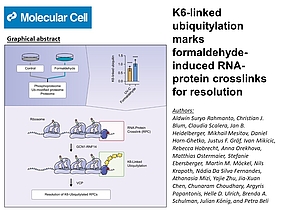New publication from the Beli Lab on a new stress response pathway for repairing RNA-Protein crosslinks caused by toxic aldehydes
Suryo Rahmanto, A., Blum, C. J., Scalera, C., Heidelberger, J. B., Mesitov, M., Horn-Ghetko, D., Gräf, J. F., Mikicic, I., Hobrecht, R., Orekhova, A., Ostermaier, M., Ebersberger, S., Möckel, M. M., Krapoth, N., Da Silva Fernandes, N., Mizi, A., Zhu, Y., Chen, J. X., Choudhary, C., Papantonis, A., Ulrich, H.D., Schulman, B.A., König, J. Beli, P. (2023). K6-linked ubiquitylation marks formaldehyde-induced RNA-protein crosslinks for resolution. Molecular cell. doi: 10.1016/j.molcel.2023.10.011
Abstract:
Reactive aldehydes are produced by normal cellular metabolism or after alcohol consumption, and they accumulate in human tissues if aldehyde clearance mechanisms are impaired. Their toxicity has been attributed to the damage they cause to genomic DNA and the subsequent inhibition of transcription and replication. However, whether interference with other cellular processes contributes to aldehyde toxicity has not been investigated. We demonstrate that formaldehyde induces RNA-protein crosslinks (RPCs) that stall the ribosome and inhibit translation in human cells. RPCs in the messenger RNA (mRNA) are recognized by the translating ribosomes, marked by atypical K6-linked ubiquitylation catalyzed by the RING-in-between-RING (RBR) E3 ligase RNF14, and subsequently resolved by the ubiquitin- and ATP-dependent unfoldase VCP. Our findings uncover an evolutionary conserved formaldehyde-induced stress response pathway that protects cells against RPC accumulation in the cytoplasm, and they suggest that RPCs contribute to the cellular and tissue toxicity of reactive aldehydes.
Read the full paper here: https://www.cell.com/molecular-cell/fulltext/S1097-2765(23)00848-1

